Training your Dachshund is a crucial part of being a responsible pet owner, and our comprehensive Dachshund training guide will help you master your pet’s skills. It can be overwhelming to embark on the training journey, but by taking it step by step and utilizing positive reinforcement techniques, you can achieve success.
- Set a strong foundation through dog obedience training.
- Incorporate games into your training regimen to make it enjoyable for your Dachshund.
- Focus on house training and crate training to establish good habits.
- Teach your Dachshund to walk on a leash and socialize them with people and animals.
- Consider using clicker training as a helpful tool along with positive reinforcement techniques.
Setting the Foundation: Dachshund Obedience Training
Building a strong foundation through Dachshund obedience training is key to a well-behaved and happy pet. Training your Dachshund to follow basic commands and exhibit good behavior not only makes your life easier but also reinforces the bond between you and your furry friend. With patience, consistency, and positive reinforcement techniques, you can lay the groundwork for a well-rounded and obedient Dachshund.
Start by teaching your Dachshund essential commands such as “sit,” “stay,” and “come.” Use treats or toys as rewards for obeying these commands, and be sure to provide plenty of praise and affection to reinforce positive behavior. Consistency is crucial during this initial stage of training, as it helps your Dachshund understand what is expected of them.
In addition to basic commands, obedience training should focus on socialization and behavior management. Expose your Dachshund to different people, animals, and environments to help them become comfortable and well-adjusted. This will reduce the likelihood of behavioral issues such as aggression or fearfulness.
| Tips for Dachshund Obedience Training: |
|---|
| 1. Keep training sessions short and frequent to maintain your Dachshund’s focus and attention. |
| 2. Use positive reinforcement techniques, such as treats, praise, and affection, to reward good behavior. |
| 3. Be patient with your Dachshund and avoid punishment-based training methods, as this can lead to fear and aggression. |
| 4. Set clear boundaries and rules for your Dachshund to follow, and be consistent in enforcing them. |
Remember, training is an ongoing process. Even after your Dachshund has mastered the basics, continue to reinforce their training by practicing commands regularly and introducing new challenges. If you encounter any behavior problems along the way, address them promptly and seek professional help if needed. By investing time and effort into Dachshund obedience training, you can raise a well-behaved and happy pet that brings joy to your life.

Training your Dachshund doesn’t have to be all work and no play – incorporating games into your training routine can make it enjoyable for both you and your furry friend. By adding a fun and interactive element to the training process, you can engage your Dachshund’s natural instincts and create a positive learning environment.
One way to incorporate play into training is through the use of toys. Interactive toys, such as puzzle toys or treat-dispensing toys, can be used as rewards for your Dachshund’s successful completion of a command or behavior. These toys provide mental stimulation and keep your Dachshund motivated and focused during training sessions.
Another fun game to try is the “find it” game. This game taps into your Dachshund’s strong sense of smell and their natural hunting instincts. Start by hiding treats or toys around the house and encourage your Dachshund to find them. This game not only provides mental stimulation but also reinforces their recall and search skills.
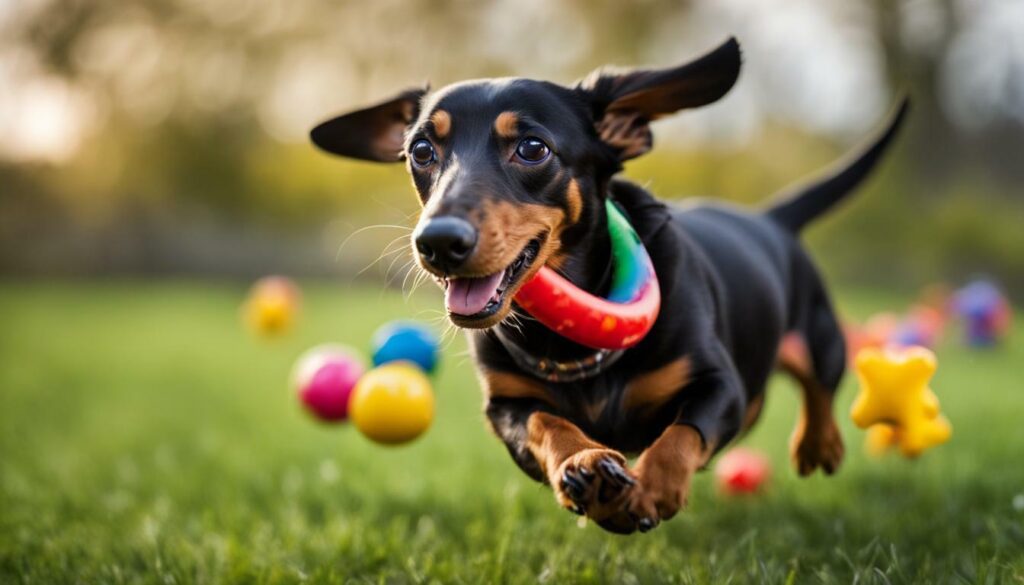
- Keep training sessions short and fun. Dachshunds have a short attention span, so aim for sessions that last no longer than 10 to 15 minutes.
- Use a variety of toys and games to keep training interesting. Rotate different toys and activities to prevent your Dachshund from getting bored.
- Always end training sessions on a positive note. Reward your Dachshund with praise, treats, or playtime, reinforcing their achievements and making training a positive experience.
Remember, training is a journey that requires time, patience, and consistency. By incorporating games into your training routine, you can enhance your Dachshund’s learning experience and strengthen the bond between you and your pet.
| Benefits of Incorporating Play into Training: |
|---|
| Increases motivation and engagement during training sessions |
| Provides mental stimulation and prevents boredom |
| Strengthens the bond between pet parent and Dachshund |
| Reinforces learned behaviors and commands |
House Training: Establishing Good Habits
House training your Dachshund is an essential part of responsible pet ownership, and with the right approach, you can establish good habits early on. The key to successful house training is consistency, patience, and positive reinforcement.
Start by establishing a routine for your Dachshund. Take them outside to their designated potty area frequently, especially after meals, naps, or playtime. Use a command such as “go potty” to associate the behavior with the command. When your Dachshund eliminates in the appropriate spot, praise and reward them with treats or verbal reinforcement.
It’s important to be vigilant and watch for signs that your Dachshund needs to go outside. These signs may include sniffing, circling, or restlessness. When you notice these behaviors, immediately take them outside to avoid accidents in the house.
Table 1: House Training Schedule
| Time | Activity |
|---|---|
| 7:00am | Take Dachshund outside to potty |
| 7:30am | Feed breakfast |
| 8:00am | Take Dachshund outside to potty |
| 12:00pm | Take Dachshund outside to potty |
| 12:30pm | Feed lunch |
| 1:00pm | Take Dachshund outside to potty |
| 5:00pm | Take Dachshund outside to potty |
| 5:30pm | Feed dinner |
| 6:00pm | Take Dachshund outside to potty |
| 9:00pm | Take Dachshund outside to potty |
| 10:00pm | Last potty break before bedtime |
Accidents may happen during the house training process, but it’s important not to punish your Dachshund. Instead, clean up any messes promptly and use an enzymatic cleaner to eliminate odors. Punishment can create fear and hinder the training progress.
By following a consistent routine, being patient, and providing positive reinforcement, you can successfully house train your Dachshund and establish good habits that will last a lifetime.
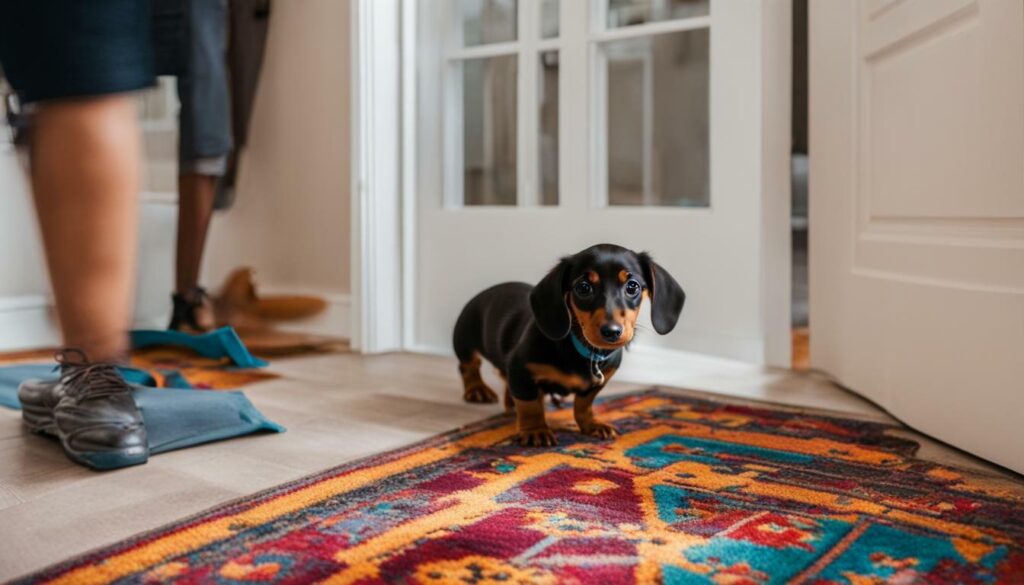
Crate training can be a valuable tool in Dachshund training, offering a safe and comfortable space for your pet while aiding in house training and behavior management. It provides a den-like environment that satisfies your Dachshund’s natural instinct for a cozy and secure place to retreat to. Crate training also helps prevent destructive behaviors when you are unable to supervise your pet, such as chewing on furniture or getting into items that could be harmful.
When introducing your Dachshund to a crate, it’s crucial to create positive associations. Make the crate inviting and comfortable by placing soft bedding and toys inside. Start by leaving the crate door open and allow your dog to explore it at their own pace. Encourage them with treats and praise when they enter the crate. Gradually increase the amount of time your Dachshund spends inside, making sure to provide plenty of positive reinforcement.
Benefits of Crate Training
- House Training: Using a crate can help establish a routine for potty training. Dogs naturally avoid soiling their sleeping area, so a well-sized crate can encourage your Dachshund to hold their bladder until it’s time for a bathroom break outside.
- Controlling Destructive Behaviors: Crate training can help prevent your Dachshund from engaging in destructive behaviors while unsupervised. By confining them to the crate, you ensure they can’t chew on furniture, get into household items, or cause any harm to themselves.
- Safe Haven: Your Dachshund will view their crate as a safe and secure space where they can relax and feel protected. This can be especially beneficial during stressful situations like thunderstorms or when you have guests over.
Remember, crate training should never be used as a form of punishment. It should be a positive experience for your Dachshund, and the crate should never be used as a means of confinement for extended periods. Always provide ample opportunities for exercise, mental stimulation, and socialization outside of the crate.
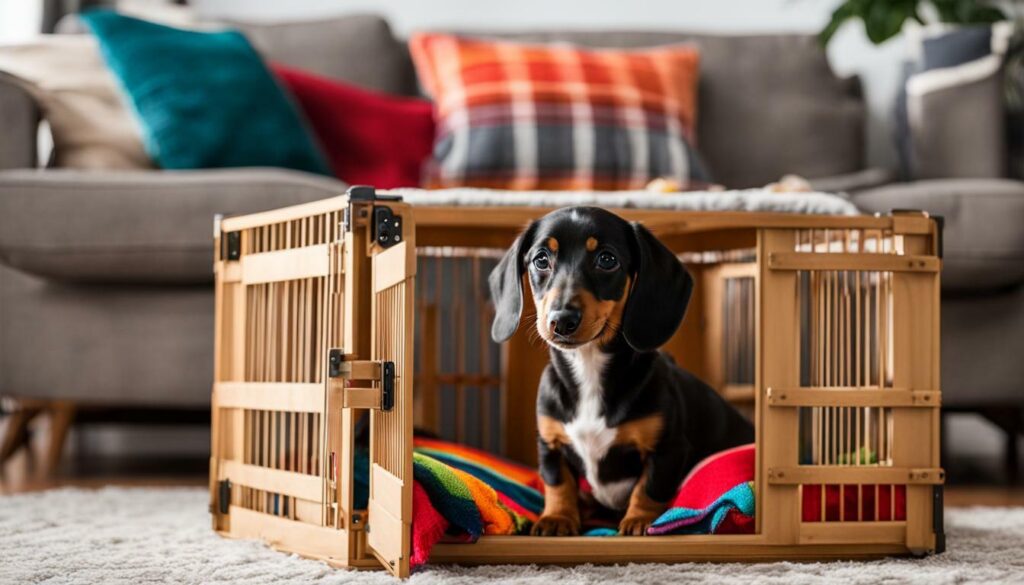
| Pros of Crate Training | Cons of Crate Training |
|---|---|
| Helps with house training | Some dogs may initially resist going into the crate |
| Prevents destructive behaviors | Improper use can cause anxiety or stress |
| Provides a safe and secure space | Some dogs may become overly dependent on the crate |
| Aids in travel and veterinary visits | Requires time, patience, and consistency |
Leash Training: Walking with Confidence
Teaching your Dachshund to walk on a leash without pulling is essential for enjoyable and safe walks together. With patience and consistency, you can train your furry friend to walk politely by your side, making your outdoor adventures stress-free and enjoyable for both of you.
Start by using a comfortable and properly fitted leash and harness or collar. This will ensure that your Dachshund is secure and comfortable during the training process. Begin in a quiet and familiar environment, such as your backyard or a quiet park, where there are minimal distractions.
One effective technique is to use positive reinforcement. Reward your Dachshund with treats, praise, and affection whenever they walk calmly by your side. Use a verbal cue, such as “heel” or “walk,” to signal your expectations. If your Dachshund starts to pull, stop walking and wait for them to return to your side. Once they do, reward them and continue walking.
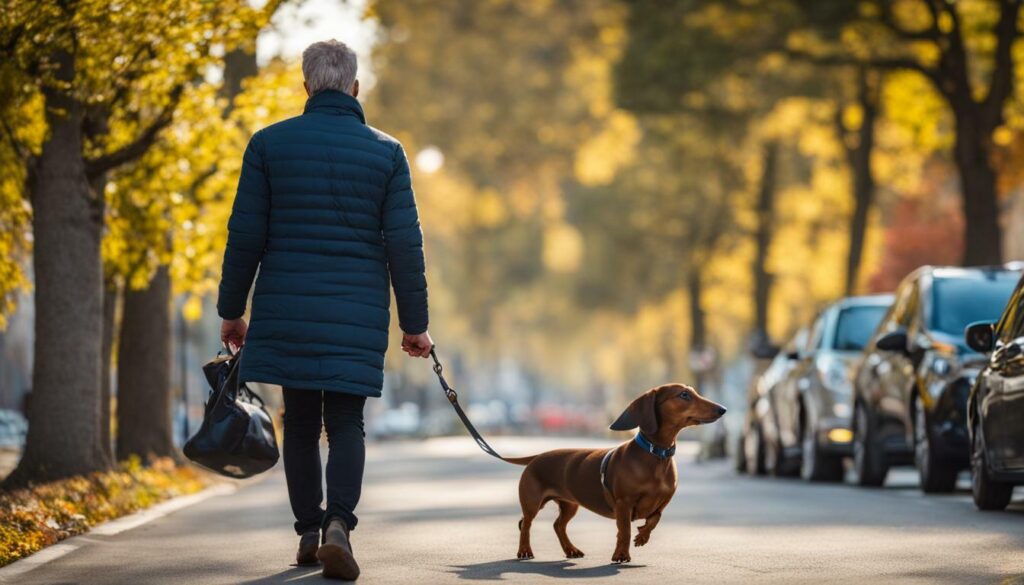
It’s important to keep training sessions short and fun. Gradually increase the duration and difficulty of the walks as your Dachshund becomes more comfortable and obedient. Remember to be patient and consistent with your training efforts, as every dog learns at their own pace.
Incorporating leash training into your Dachshund’s routine will not only ensure their safety but also strengthen the bond between you and your furry companion. So grab your leash, put on your walking shoes, and embark on a journey of confident and enjoyable walks with your Dachshund.
Leash Training Tips:
- Choose a comfortable and properly fitted leash and harness or collar.
- Start training in a quiet and familiar environment with minimal distractions.
- Use positive reinforcement, such as treats and praise, to reward your Dachshund for walking calmly by your side.
- If your Dachshund starts to pull, stop walking and wait for them to return to your side before continuing.
- Keep training sessions short, fun, and gradually increase the duration and difficulty of the walks.
Complete Table: Leash Training Schedule
| Week | Training Goals |
|---|---|
| 1 | Introduce leash and teach “heel” cue |
| 2 | Practice walking in a distraction-free environment |
| 3 | Gradually increase the duration of walks |
| 4 | Work on loose leash walking in more challenging settings |
| 5 | Continue reinforcing good leash manners and obedience |
Socialization: Building Positive Relationships
Socialization is a vital aspect of Dachshund behavior training, helping your pet develop positive relationships with people and other animals. By exposing your Dachshund to various environments, situations, and interactions from an early age, you can help them become well-rounded and confident companions.
One effective technique for socializing your Dachshund is by arranging playdates with other friendly and vaccinated dogs. This allows them to learn appropriate canine communication and behavior, as well as how to navigate different social dynamics. Supervise these interactions to ensure safety and step in if any signs of discomfort or aggression arise.
Introducing your Dachshund to new people is equally important. Encourage polite and calm greetings, rewarding them for good behavior. It’s crucial to expose your Dachshund to people of various ages, appearances, and behaviors, including children, to help them become comfortable in different social settings. Always prioritize your Dachshund’s safety and well-being, and never force interactions if they appear fearful or anxious.
| Benefits of Socialization: | Techniques for Successful Socialization: |
|---|---|
|
|
Remember that each Dachshund is unique, and their socialization needs may vary. Pay attention to their body language and adjust your approach accordingly. With patience, consistency, and love, you can help your Dachshund develop into a well-socialized and happy companion.

Clicker training can be a valuable addition to your Dachshund training toolkit, enhancing positive reinforcement techniques for effective learning. This method involves using a small device, called a clicker, to mark desired behaviors, followed by a reward. The sound of the clicker serves as a clear signal, helping your Dachshund associate it with a job well done.
When incorporating clicker training into your Dachshund’s training routine, it’s important to start with simple commands and behaviors. For example, you can use the clicker to mark and reward your Dachshund for sitting on command. Begin by clicking the device the moment your pet’s bottom touches the ground, followed immediately by a treat. With consistency and repetition, your Dachshund will quickly understand that the clicker means they have performed the desired behavior and will be rewarded.
One of the advantages of clicker training is its precision. By using the clicker to mark specific moments of desired behavior, you can provide your Dachshund with instant feedback, making it easier for them to understand what they are being rewarded for. This method also helps strengthen the bond between you and your pet, as it encourages clear communication and trust.
| Benefits of Clicker Training | Tips for Clicker Training |
|---|---|
|
|
Remember, clicker training should always be conducted in a positive and supportive manner. Patience and consistency are key, as your Dachshund learns to associate the clicker with the reward. With time and practice, clicker training can help your Dachshund master new commands and behaviors, making the training process more enjoyable for both of you.

Congratulations on mastering the basics! But the learning doesn’t stop there – continue to challenge your Dachshund with new training techniques and commands to keep their skills sharp and their minds engaged.
One aspect of ongoing training is to introduce your Dachshund to more advanced commands and tricks. Building on the foundation you have established, you can teach your pet impressive tricks like roll over, play dead, or even fetch specific items. These advanced commands not only provide mental stimulation for your Dachshund but also strengthen the bond between you and your furry friend.
Another important aspect of continual learning is to proof the behaviors your Dachshund has already mastered. This means practicing commands and behaviors in different environments and with distractions present. By doing so, you are ensuring that your Dachshund can perform these skills reliably, regardless of the situation.
If any behavior problems arise, it’s important to address them promptly. Whether it’s excessive barking, jumping on people, or separation anxiety, consistent training techniques can help modify unwanted behaviors. Seek guidance from a professional dog trainer or behaviorist if needed, to ensure you are using effective and humane methods to address these issues.
Remember, training should be a positive and rewarding experience for both you and your Dachshund. Consistency, patience, and love are key to success. Enjoy the journey of training your Dachshund and celebrate the milestones along the way.
FAQ
What is the importance of training for both the pet parent and the Dachshund?
Training is essential for both the pet parent and the Dachshund as it establishes a bond, promotes good behavior, and ensures a happy and well-adjusted dog.
What is the first step in Dachshund training?
The first step in Dachshund training is to set a foundation through a dog obedience program. This will help establish basic commands and behaviors.
How can I make Dachshund training fun?
Incorporating games and play into training can make it fun for your Dachshund. Using toys and positive reinforcement techniques can enhance the training experience.
What is the best way to house train a Dachshund?
To house train a Dachshund, establish a routine, provide frequent potty breaks, reward desired behavior, and be consistent with positive reinforcement. Crate training can also be helpful.
How do I crate train my Dachshund?
To crate train your Dachshund, introduce them gradually to the crate, make it a positive space, and use treats and praise to reinforce good behavior inside the crate.
How can I teach my Dachshund to walk on a leash?
To teach your Dachshund to walk on a leash, start with short walks, use positive reinforcement, avoid pulling or dragging, and be patient and consistent with training.
Why is socialization important for Dachshunds?
Socialization is important for Dachshunds to help them feel comfortable around people and other animals, reduce fear and aggression, and promote positive behavior in various situations.
What is clicker training and how can it benefit Dachshund training?
Clicker training is a technique that uses a clicking sound to mark desired behaviors and reinforce them with treats or praise. It can help clarify communication and speed up learning for Dachshunds.
Why is ongoing training important even after basic commands are mastered?
Ongoing training keeps Dachshunds mentally stimulated, reinforces good behavior, and allows for the learning of advanced commands and tricks. It also helps address any behavior problems that may arise.
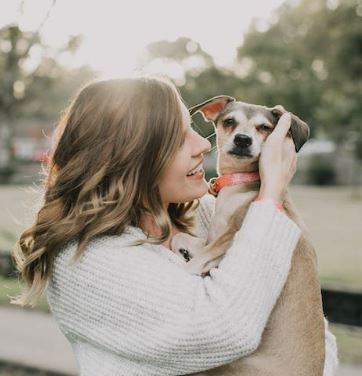
Marissa Delotta, 36, from Dayton, Ohio, is the creative force behind Roverboard.com, a beloved online destination for dog lovers. As a dedicated mom and canine enthusiast, Marissa combines her family experiences with her love for dogs to offer a platform where dog owners can exchange tips, heartwarming stories, and advice. Her website has become a vibrant community for sharing the joys of dog parenting. In her free time, Marissa enjoys exploring dog parks with her family and volunteering at local animal shelters.